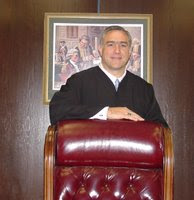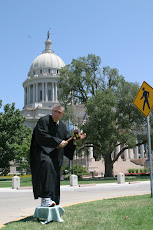
Sunday, August 30, 2009
What you did not see!

Wednesday, July 15, 2009
WHERE IS OUR CONSTITUTION?
We blindly trusted the Bush administration to do "what needed to be done" in order to fight terrorism. We largely ignored, by failing to ask the hard questions, any constitutional usurpation. Now, only in the light of something that matters to us - loss of economic prosperity - have we begun to wipe the sleep from our eyes. Yes, that's right, until we were hit in the pocketbook we weren't paying attention. Are we going to remain asleep during another administration?
Is the "bail out" constitutional? Does the United States Constitution, Article 1, Section 8 prohibit the bail out? Hmm ... Congress may tax and spend for three things. Is the bail out among those things for which Congress may tax and spend?
What about the United States now being the majority owner of significant industry? Essentially we have turned private industry into public industry. Not only does the United States now have a significant financial stake in what was once private industry, but the United States has unprecedented power to make decisions regarding those industries. Wow ... does this seem like a "free market economy" to you?
Articles regarding these subjects and more will be forth coming. Please feel free to email me at profesc.research@gmail.com and let me know the particular topics that interest you.
Friday, March 20, 2009
Emergency, Temporary Change of Custody - Standards and Quantums of Evidence
Hmmm ... what is a "quantum of evidence?" That is more familiar as: 1) Beyond a reasonable doubt; 2) Clear and convincing evidence; or 3) Preponderance of the evidence. The function of a standard of proof, as that concept is embodied in the Due Process Clause and in the realm of fact finding, is to instruct the fact finder concerning the degree of confidence our society thinks he should have in the correctness of factual conclusions for a particular type of adjudication. The standard serves to allocate the risk of error between the litigants and to indicate the relative importance attached to the ultimate decision (Addington v. Texas, 441 U.S. 418, 423, 99 S.Ct. 1804, 1808 [U.S.Tex.,1979]; See also In re Winship, 397 U.S. 358, 370, 90 S.Ct. 1068, 1076, 25 L.Ed.2d 368 [1970] [Harlan, J., concurring]).
Obviously, the non-moveant is most protected if the moving party has the burden of proving their case by the first quantum - beyond a reasonable doubt. That standard applies to the guilt or innocence of a criminal defendant (Hogan v. State, 139 P.3d 907, 923 [Okla.Crim.App.,2006]). The clear-and-convincing standard is employed in civil cases involving allegations of fraud or some other quasi-criminal wrongdoing by the defendant. The interest at stake in those cases is deemed to be more substantial than mere loss of money and some jurisdictions reduce the risk to the defendant of having his reputation tarnished erroneously by increasing the plaintiff's burden of proof (Johnson v. Board of Governors of Registered Dentists of State of Okl., 913 P.2d 1339, 1345 [Okl.,1996]). The parties equally share the risk with the third quantum - preponderance of the evidence (Id.). What quantum of evidence was applied in the K-9 fecal case? We do not, and will never, know. It was not specifically enumerated on the record and current law establishes no specific quantum as applied to emergency, temporary change of custody actions.
It seems that the problem, when one understands the purposes intended to be served by enumerated legal standard and quantum of evidence, suggests the answer. The more general standard of "best interest of the child", should be applied to ordinary change of custody motions (assuming the Gibbons standard of permanent, substantial, material change of condition(s) have been met). Emergency, temporary change of custody motions, however, imply by their very nature that a temporary change is in the best interest of the child(ren). Thus, a good standard and quantum for emergency, temporary change of custody could be:
"Actual physical or psychological harm to a parent or child proven by preponderance of the evidence" or "A credible threat of physical or psychological harm to a parent or child proven by clear and convincing evidence."
First, one need not - and would not likely be able to - prove actual, or a credible threat of physical or psychological harm beyond a reasonable doubt. Setting such a high quantum would result in many children remaining in harm's way while investigations are conducted. During the conduct of investigations, at-risk children could be permanently harmed. Thus, beyond a reasonable doubt is not an appropriate standard for an emergency, temporary change of custody. Since a "threat of harm" is less concrete than "actual" harm, the quantum of "clear and convincing" is most appropriate. This standard liens toward protecting the party from whom custody is potentially being removed - a change of custody is more than the loss of mere money and could potentially harm the non-moveant's reputation. Proving actual harm is a bit easier, i.e. bruising, police reports, expert testimony etc. When dealing with actual, physical harm all the evidence is in plain view and the parties should equally bare the risk of error. Thus, the lesser standard of preponderance of the evidence is most appropriate.
A legal standard determines the substance sought (i.e. gold), while the quantum of evidence determines the size of screens built into the legal sifter. The suggested standard would permit lawyers to accurately assay their clients' circumstances and determine when an actual "emergency" exists. It would also permit Judges, especially when an ex parte motion requires temporary deprivation of substantive and procedural due process, to provide more consistent and well reasoned results until all parties can have "their day in court."
The question of appropriate legal standard and applicable quantum of evidence is clearly a question capable of repetition while evading review. Hopefully, even if the pending writ is mooted by litigant conduct, the S.Ct. will answer the question. Enumerating a legal standard and quantum of evidence for emergency, temporary change of custody will result in consistency of decisions and, thus, will decrease acrimonious and costly litigation. The best interests of Oklahoma children will be best served by an established standard/quantum applied in an even-handed manner.
Saturday, February 28, 2009
Oklahoma Judge Richard Kirby Overturned - but Two had already Suffered Unconsitutional Jail Sentences at the hands of his honor

Wednesday, February 25, 2009
Santa Clause, The Easter Bunny The Tooth Fairy and Divorce
Amicable divorce is much like Santa Clause, the Easter Bunny and the Tooth Fairy – we all know they are fantasies, but we intently want to believe each of their surreal images and the concomitant message of perennial hope. Awaking with a licentious hang-over throbbing in one’s libido only to discover his/her matrimonial bonds were formed with defective emotional epoxy is a traumatic event – particularly when there are minor children involved. Nonetheless, most couples embark upon the task of seeking the ever elusive amicable divorce.
With the betrothed now having become the begrudged, the best of parsimonious intentions turn into acrimonious conduct with each party seeking legal validation of their emotional positions. Parties often seek a post-connubial order visiting maximum legal malevolence upon the other. This is especially true if one of the parties had entertained the company of an extra-nuptial paramour. The spurned spouse will often request a “be good” order seeking to preclude the other spouse from having the former paramour spend the night during visitation or shared custody with the parties’ children. In a temporary order, such a condition seems harmless enough. However, a constitutional issue arises when a decree or post-decree order contains “be good” language.
Freedom of association must be free from obstruction by state government.[1] Parents’ rights to exercise control over their childrens’ upbringing, education and other aspects, has long been held to be constitutionally protected.[2] Moreover, when a State seeks to inquire about an individual's associations, a heavy burden lies upon it to show that the inquiry is necessary to protect a legitimate state interest.[3] The test for sticking a governmental nose into parents’ rights to determine who may see their children is two pronged: What will serve the best interests of the child; weighed against what harm will come to the child without state meddling.[4] State invasion into parents’ rights to determine those with whom their children may have contact is a serious constitutional digression.[5]
Florida’s public policy is to assure a minor child frequent and continuing contact with both parents after marriage has been dissolved.[6] That being true, absent a showing that the parent’s new significant other presents a danger to the child, any state interference with who the parent permits his/her children to interact with is simply unconstitutional. If, on the other hand, the parents’ agree that neither will have a visitor of the opposite sex spend the night when they have the children, having that put into a court order would not necessarily be unconstitutional. However, if one parent subsequently fails to abide by that agreed order, can one be held in contempt?
There are no cases directly on point, but there are at least two ways to assay that conundrum: A traditional contractual analysis, i.e. offer, acceptance and consideration. Even under a contract analysis, it is non sequitur that a court could enforce a contract with the semi-criminal procedure of in-direct contempt. The second manner in which to analyze the issue is one of simply enforcing a court order. Much like the first analysis, it seems non sequitur that a court could punish with a quasi-criminal action that which it lacked constitutional authority to order in the first place.
Ultimately, the argument that it is immoral – and therefore not in the best interest of the child and, in fact damaging to the child – to expose the parties’ child(ren) to a live-in or overnight paramour during visitation does not pass constitutional muster. Of course, Florida has a legitimate and compelling interest in protecting children. However, absent specific justification, that line is crossed when a court projects its glomming governmental fingers into the parents’ constitutional pie. No matter how morally repugnant each of us or the court may find the fact that children are exposed to a parent with a live-in, unmarried significant other, absent a specific showing of detriment to the child(ren)’s interests, the courts may not superimpose their morality over the law. Indeed, such judicial activism will not find repose in the cool shade of our constitutionally rooted tree.
[1] Santa Fe Indep. Sch. Dist. v. Doe, 530 U.S. 290, 301 (U.S. 2000).
[2] Pierce v. Soc'y of Sisters, 268 U.S. 510, 534 (U.S. 1925)
[3] Baird v. State Bar of Ariz., 401 U.S. 1, 6-7 (U.S. 1971).
[4] Clearly, this Court has consistently held all statutes that have attempted to compel visitation or custody with a grandparent based solely on the best interest of the child standard, without the required showing of harm to the child, to be unconstitutional. We agree with the district court below and likewise hold that section 61.13(2)(b)2.c. of the Florida Statutes is unconstitutional as violative of Florida's right of privacy because it fails to require a showing of harm to the child prior to compelling and forcing the invasion of grandparent visitation into the parental privacy rights. Section 61.13(2)(b)2.c. provides that a court "may award the grandparents visitation rights with a minor child if it is in the child's best interest."§ 61.13(2)(b)2.c., Fla. Stat. (2001). This provision does not require a showing of the essential element of harm to the child should visitation with a grandparent be denied (Sullivan v. Sapp, 866 So. 2d 28, 37-38 [Fla. 2004]).
[5] Id.
[6] Schutz v. Schutz, 581 So. 2d 1290, 1293 (Fla. 1991)



